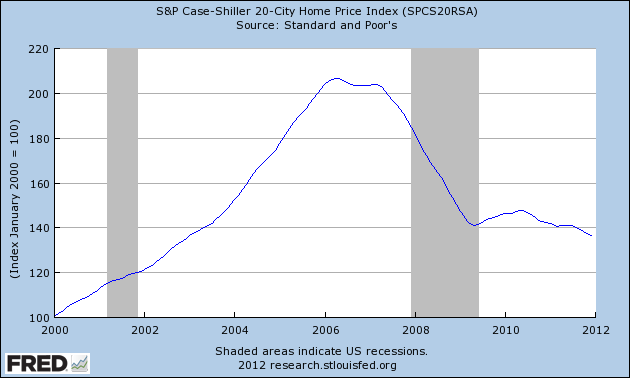The negative effects of the American housing bubble crisis are still being felt in residential neighborhoods across the United States. A recent report from the S&P/Case-Shiller housing price index shows that prices of single family homes in 20 metro areas fell 0.7 percent in November of last year, and 0.5 percent the next month. The S&P/Case-Shiller index is now at a record low level that was last seen in 2003, a crucial year in the history of the housing bubble.

The negative effects of the American housing bubble crisis are still being felt in residential neighborhoods across the United States. A recent report from the S&P/Case-Shiller housing price index shows that prices of single family homes in 20 metro areas fell 0.7 percent in November of last year, and 0.5 percent the next month. The S&P/Case-Shiller index is now at a record low level that was last seen in 2003, a crucial year in the history of the housing bubble.
The S&P/Case-Shiller index is a respected barometer of the real estate economy. The original firm behind the index, Case Shiller Weiss, has been compiling and analyzing real estate statistics since the early 1990s. In 2002, financial analytic giants Standard & Poor's acquired Case Shiller Weiss and began marketing several housing indices. The S&P/Case-Shiller composite 20 index, abbreviated as SPCS20R, takes a close look at home prices in Detroit, Tampa, Las Vegas, and 17 other Metropolitan Statistical Areas (MSAs). The current value of the SPCS20R, 136.63, is nearly the lowest in the history of the index.
Out of the 20 MSAs that make up the SPCS20R index, 19 of them experienced downward activity in 2011.
The recent activity of the SPCS20R has been in line with projections from the economists. For real estate investors and individuals looking to get a bargain home purchase in the 20 (MSAs), the last two years have been very challenging in terms to finding a true bottom in housing prices. This elusive bottom can be attributed to the feeble strengthening of the American economy. Until significantly positive economic data is observed, slight drops in the SPCS20R can be expected.
Economists and real estate analysts who closely follow the SPCS20R do not discount the possibility of the index reaching an all-time low in 2012. With the current amount of pending foreclosures and an unemployment rate that is still considerably high, the SPCS20R and other housing indices could still face downward movement before they stabilize.
The S&P/Case-Shiller index is a respected barometer of the real estate economy. The original firm behind the index, Case Shiller Weiss, has been compiling and analyzing real estate statistics since the early 1990s. In 2002, financial analytic giants Standard & Poor's acquired Case Shiller Weiss and began marketing several housing indices. The S&P/Case-Shiller composite 20 index, abbreviated as SPCS20R, takes a close look at home prices in Detroit, Tampa, Las Vegas, and 17 other Metropolitan Statistical Areas (MSAs). The current value of the SPCS20R, 136.63, is nearly the lowest in the history of the index.
Out of the 20 MSAs that make up the SPCS20R index, 19 of them experienced downward activity in 2011.
The recent activity of the SPCS20R has been in line with projections from the economists. For real estate investors and individuals looking to get a bargain home purchase in the 20 (MSAs), the last two years have been very challenging in terms to finding a true bottom in housing prices. This elusive bottom can be attributed to the feeble strengthening of the American economy. Until significantly positive economic data is observed, slight drops in the SPCS20R can be expected.
Economists and real estate analysts who closely follow the SPCS20R do not discount the possibility of the index reaching an all-time low in 2012. With the current amount of pending foreclosures and an unemployment rate that is still considerably high, the SPCS20R and other housing indices could still face downward movement before they stabilize.




